Current Status and Willingness to Adopt Renewable Energy Technologies in Saudi Arabia
Abstract
1. Introduction
2. Literature Review
2.1. Renewable Energy Technologies
2.1.1. Solar Energy
2.1.2. Wind Energy
2.1.3. Geothermal Energy
2.1.4. Hydro Energy
2.1.5. Biomass Energy
2.1.6. Wave Energy
2.2. Willingness to Pay and Invest in Renewable Energy Technologies Worldwide
3. Methodology
- χ2 is the Pearson’s chi-square statistic
- i is the row number in the contingency table
- j is the column number in the contingency table
- Oij is the observed frequency
- Eij is the expected frequency
- RTi is the row total
- CTj is the column total
- n is the total number of observations
- df is degrees of freedom
- r is number of rows
- c is number of columns
4. Data Analysis and Results Discussion
4.1. Sociodemographic Characteristics
4.2. Background Knowledge on RETs
4.3. Sociodemographic Characteristics versus Background Knowledge on RET Sources
4.4. Willingness Perspectives to Adopt RET Sources
4.5. Sociodemographic Characteristics versus Willingness Perspectives to Adopt RET Sources
5. Conclusions
Author Contributions
Funding
Conflicts of Interest
References
- Alkhathlan, K.; Javid, M. Energy consumption, carbon emissions and economic growth in Saudi Arabia: An aggregate and disaggregate analysis. Energy Policy 2013, 62, 1525–1532. [Google Scholar] [CrossRef]
- Alshehry, A.; Belloumi, M. Energy consumption, carbon dioxide emissions and economic growth: The case of Saudi Arabia. Renew. Sustain. Energy Rev. 2015, 41, 237–247. [Google Scholar] [CrossRef]
- Yamada, M. Vision 2030 and the Birth of Saudi Solar Energy; Middle East Institute: Washington, DC, USA, 2016. [Google Scholar]
- Fattouh, B.; Sen, A. Saudi Arabia’s Vision 2030, Oil Policy and the Evolution of the Energy Sector; The Oxford Institute for Energy Studies, University of Oxford: Oxford, UK, 2016. [Google Scholar]
- Vision 2030. Vision 2030, Kingdom of Saudi Arabia; Vision 2030: Riyadh, Saudi Arabia, 2016. [Google Scholar]
- Borgmann, M. Potentially Game-Changing Saudi Arabian Government Restructuring Bolsters 9.5 GW Renewable Energy Target by 2023. Available online: http://www.apricum-group.com/saudi-arabia-announces-9-5-gw-renewable-energy-target-new-king-salman-renewable-energy-initiative/ (accessed on 25 October 2016).
- Su, W.; Liu, M.; Zeng, S.; Štreimikienė, D.; Baležentis, T.; Ališauskaitė-Šeškienė, I. Valuating renewable microgeneration technologies in Lithuanian households: A study on willingness to pay. J. Clean. Prod. 2018, 191, 318–329. [Google Scholar] [CrossRef]
- Ribeiro, F.; Ferreira, P.; Araújo, M.; Braga, A. Modelling perception and attitudes towards renewable energy technologies. Renew. Energy 2018, 122, 688–697. [Google Scholar] [CrossRef]
- Seigo, S.; Dohle, S.; Siegrist, M. Public perception of carbon capture and storage (CCS): A review. Renew. Sustain. Energy Rev. 2014, 38, 848–863. [Google Scholar] [CrossRef]
- Chimres, N.; Wongwises, S. Critical review of the current status of solar energy in Thailand. Renew. Sustain. Energy Rev. 2016, 58, 198–207. [Google Scholar] [CrossRef]
- Kabir, E.; Kumar, P.; Kumar, S.; Adelodun, A.; Kim, K. Solar energy: Potential and future prospects. Renew. Sustain. Energy Rev. 2018, 82, 894–900. [Google Scholar] [CrossRef]
- Salam, M.; Khan, S. Transition towards sustainable energy production—A review of the progress for solar energy in Saudi Arabia. Energy Explor. Exploit. 2018, 36, 3–27. [Google Scholar] [CrossRef]
- Sansaniwal, S.; Sharma, V.; Mathur, J. Energy and exergy analyses of various typical solar energy applications: A comprehensive review. Renew. Sustain. Energy Rev. 2018, 82, 1576–1601. [Google Scholar] [CrossRef]
- Ferreira, A.; Kunh, S.; Fagnani, K.; Souza, T.; Tonezer, C.; Santos, G.; Coimbra-Araújo, C. Economic overview of the use and production of photovoltaic solar energy in brazil. Renew. Sustain. Energy Rev. 2018, 81, 181–191. [Google Scholar] [CrossRef]
- Destouni, G.; Frank, H. Renewable Energy. R. Swed. Acad. Sci. 2010, 39, 18–21. [Google Scholar] [CrossRef]
- Tripathi, L.; Mishra, A.; Dubey, A.; Tripathi, C.; Baredar, P. Renewable energy: An overview on its contribution in current energy scenario of India. Renew. Sustain. Energy Rev. 2016, 60, 226–233. [Google Scholar] [CrossRef]
- Yuan, X.; Zuo, J.; Huisingh, D. Social acceptance of wind power: A case study of Shandong Province, China. J. Clean. Prod. 2015, 92, 168–178. [Google Scholar] [CrossRef]
- Liu, S.; Ho, Y. Wind energy applications for Taiwan buildings: What are the challenges and strategies for small wind energy systems exploitation? Renew. Sustain. Energy Rev. 2016, 59, 39–55. [Google Scholar] [CrossRef]
- Abolude, A.; Zhou, W. A preliminary analysis of wind turbine energy yield. Energy Procedia 2017, 138, 423–428. [Google Scholar] [CrossRef]
- Singh, A.; Parida, S. Evaluation of current status and future directions of wind energy in India. Clean Technol. Environ. Policy 2013, 15, 643–655. [Google Scholar] [CrossRef]
- Kaplan, Y. Overview of wind energy in the world and assessment of current wind energy policies in Turkey. Renew. Sustain. Energy Rev. 2015, 43, 562–568. [Google Scholar] [CrossRef]
- Allouhi, A.; Zamzoum, O.; Saidurc, M.; Kousksou, T.; Jamil, A.; Derouich, A. Evaluation of wind energy potential in Morocco’s coastal regions. Renew. Sustain. Energy Rev. 2017, 72, 311–324. [Google Scholar] [CrossRef]
- Dupont, E.; Koppelaar, R.; Jeanmart, H. Global available wind energy with physical and energy return on investment constraints. Appl. Energy 2018, 209, 322–338. [Google Scholar] [CrossRef]
- Herez, A.; Khaled, M.; Murr, R.; Haddad, A.; Elhage, H.; Ramadan, M. Using geothermal energy for cooling—Parametric study. Energy Procedia 2017, 119, 783–791. [Google Scholar] [CrossRef]
- Vasquez, O. Life cycle analysis of geothermal energy for power and transportation: A stochastic approach. Renew. Energy 2018, 115, 371–381. [Google Scholar]
- Sui, D.; Langåker, V.; Yu, Z. Investigation of thermophysical properties of Nanofluids for application in geothermal energy. Energy Procedia 2017, 105, 5055–5060. [Google Scholar] [CrossRef]
- Pellizzone, A.; Allansdottir, A.; Franco, R.; Muttoni, G.; Manzella, A. Geothermal energy and the public: A case study on deliberative citizens’ engagement in central Italy. Energy Policy 2017, 101, 561–570. [Google Scholar] [CrossRef]
- Shortall, R.; Davidsdottir, B.; Axelsson, G. Geothermal energy for sustainable development: A review of sustainability impacts and assessment frameworks. Renew. Sustain. Energy Rev. 2015, 44, 391–406. [Google Scholar] [CrossRef]
- Nasruddin; Alhamid, M.; Daud, Y.; Surachman, A.; Sugiyono, A.; Aditya, H.; Mahlia, T. Potential of geothermal energy for electricity generation in Indonesia: A review. Renew. Sustain. Energy Rev. 2016, 53, 733–740. [Google Scholar] [CrossRef]
- Gondal, I.; Masood, S.; Amjad, M. Review of geothermal energy development efforts in Pakistan and way forward. Renew. Sustain. Energy Rev. 2017, 71, 687–696. [Google Scholar] [CrossRef]
- Singh, V.; Singal, S. Operation of hydro power plants-a review. Renew. Sustain. Energy Rev. 2017, 69, 610–619. [Google Scholar] [CrossRef]
- Aroonrat, K.; Wongwises, S. Current status and potential of hydro energy in Thailand: A review. Renew. Sustain. Energy Rev. 2015, 46, 70–78. [Google Scholar] [CrossRef]
- Sharma, A.; Thakur, N. Energy situation, current status and resource potential of run of the river (RoR) large hydro power projects in Jammu and Kashmir: India. Renew. Sustain. Energy Rev. 2017, 78, 233–251. [Google Scholar] [CrossRef]
- Kumar, A.; Kumar, N.; Baredar, P.; Shukla, A. A review on biomass energy resources, potential, conversion and policy in India. Renew. Sustain. Energy Rev. 2015, 45, 530–539. [Google Scholar] [CrossRef]
- Toklu, E. Biomass energy potential and utilization in Turkey. Renew. Energy 2017, 107, 235–244. [Google Scholar] [CrossRef]
- Bilgili, F.; Koçak, E.; Bulut, Ü.; Kuşkaya, S. Can biomass energy be an efficient policy tool for sustainable development? Renew. Sustain. Energy Rev. 2017, 71, 830–845. [Google Scholar] [CrossRef]
- Schuenemann, F.; Msangi, S.; Zeller, M. Policies for a sustainable biomass energy sector in Malawi: Enhancing energy and food security simultaneously. World Dev. 2018, 103, 14–26. [Google Scholar] [CrossRef]
- Gonzalez-Salazar, M.; Morini, M.; Pinelli, M.; Spina, P.; Venturini, M.; Finkenrath, M.; Poganietz, W. Methodology for estimating biomass energy potential and its application to Colombia. Appl. Energy 2014, 136, 781–796. [Google Scholar] [CrossRef]
- Herbert, G.; Krishnan, A. Quantifying environmental performance of biomass energy. Renew. Sustain. Energy Rev. 2016, 59, 292–308. [Google Scholar] [CrossRef]
- Mao, G.; Zou, H.; Chen, G.; Du, H.; Zuo, J. Past, current and future of biomass energy research: A bibliometric analysis. Renew. Sustain. Energy Rev. 2015, 52, 1823–1833. [Google Scholar] [CrossRef]
- Mustapa, M.; Yaakob, O.; Ahmed, Y.; Rheem, C.; Koh, K.; Adnan, F. Wave energy device and breakwater integration: A review. Renew. Sustain. Energy Rev. 2017, 77, 43–58. [Google Scholar] [CrossRef]
- Lucero, F.; Catalan, P.; Ossandon, A.; Beya, J.; Puelma, A.; Zamorano, L. Wave energy assessment in the central-south coast of Chile. Renew. Energy 2017, 114, 120–131. [Google Scholar] [CrossRef]
- Bouhrim, H.; Marjani, A. On the shoreline wave energy potential and its conversion in Morocco. Energy Procedia 2017, 139, 111–116. [Google Scholar] [CrossRef]
- Ulazia, A.; Penalba, M.; Ibarra-Berastegui, G.; Ringwood, J.; Saenz, J. Wave energy trends over the Bay of Biscay and the consequences for wave energy converters. Energy 2017, 141, 624–634. [Google Scholar] [CrossRef]
- Chen, Z.; Yu, H.; Hu, M.; Meng, G.; Wen, C. A Review of offshore wave energy extraction system. Adv. Mech. Eng. 2013, 2013, 1–9. [Google Scholar] [CrossRef]
- Santhosh, N.; Baskaran, V.; Amarkarthik, A. A review on front end conversion in ocean wave energy converters. Front. Energy 2015, 9, 297–310. [Google Scholar] [CrossRef]
- Heras-Saizarbitoria, I.; Cilleruelo, E.; Zamanillo, I. Public acceptance of renewables and the media: An analysis of the Spanish PV solar experience. Renew. Sustain. Energy Rev. 2011, 15, 4685–4696. [Google Scholar] [CrossRef]
- Ribeiro, F.; Ferreira, P.; Araújo, M.; Braga, A. Public opinion on renewable energy technologies in Portugal. Energy 2014, 69, 39–50. [Google Scholar] [CrossRef]
- Rijnsoever, F.; Farla, J. Identifying and explaining public preferences for the attributes of energy technologies. Renew. Sustain. Energy Rev. 2014, 31, 71–82. [Google Scholar] [CrossRef]
- West, J.; Bailey, I.; Winter, M. Renewable energy policy and public perceptions of renewable energy: A cultural theory approach. Energy Policy 2010, 38, 5739–5748. [Google Scholar] [CrossRef]
- Baharoon, D.; AbdulRahman, H.; Fadhl, S. Publics’ knowledge, attitudes and behavioral toward the use of solar energy inYemen power sector. Renew. Sustain. Energy Rev. 2016, 60, 498–515. [Google Scholar] [CrossRef]
- Ntanos, S.; Kyriakopoulos, G.; Chalikias, M.; Arabatzis, G.; Skordoulis, M. Public Perceptions and Willingness to Pay for Renewable Energy: A Case Study from Greece. Sustainability 2018, 10, 687. [Google Scholar] [CrossRef]
- Paravantis, J.; Stigka, E.; Mihalakakou, G.; Michalena, E.; Hills, J.; Dourmas, V. Social acceptance of renewable energy projects: A contingent valuation investigation in Western Greece. Renew. Energy 2018, 123, 639–651. [Google Scholar] [CrossRef]
- Zografakis, N.; Sifaki, E.; Pagalou, M.; Nikitaki, G.; Psarakis, V.; Tsagarakis, K. Assessment of public acceptance and willingness to pay for renewable energy sources in Crete. Renew. Sustain. Energy Rev. 2010, 14, 1088–1095. [Google Scholar] [CrossRef]
- Yau, Y. Willingness to pay and preferences for green housing attributes in Hong Kong. J. Green Build. 2012, 7, 137–152. [Google Scholar] [CrossRef]
- Lee, I.; Chen, H.; Tiong, R. An Investigation into Tenant Organizations’ willingness-to-Pay for the Intangible Value-Added Benefits of Sustainable Buildings: Case Study in Singapore. J. Green Build. 2015, 10, 191–213. [Google Scholar] [CrossRef]
- Faul, F.; Erdfelder, E.; Lang, G.; Buchner, A. G* Power 3: A flexible statistical power analysis program for the social, behavioral, and biomedical sciences. Behav. Res. Methods 2007, 39, 175–191. [Google Scholar] [CrossRef] [PubMed]
- Faul, F.; Erdfelder, E.; Buchner, A.; Lang, A. Statistical power analyses using G*Power 3.1: Tests for correlation and regression analyses. Behav. Res. Methods 2009, 41, 1149–1160. [Google Scholar] [CrossRef] [PubMed]
- Field, A. Discovering Statistics Using IBM SPSS Statistics; Sage Publications: Thousand Oaks, CA, USA, 2013. [Google Scholar]
- Cohen, J. Statistical Power Analysis for the Behavioral Sciences; Erlbaum: Hillsdale, NJ, USA, 1988. [Google Scholar]
- Cohen, J. A power primer. Psychol. Bull. 1992, 112, 155–159. [Google Scholar] [CrossRef] [PubMed]
- Fisher, R. On the interpretation of χ2 from contingency tables, and the calculation of P. J. R. Stat. Soc. 1922, 85, 87–94. [Google Scholar] [CrossRef]
- Pearson, K. On the criterion that a given system of deviations from the probable in the case of a correlated system of variables is such that it can be reasonably supposed to have arisen from random sampling. Lond. Edinb. Dublin Philos. Mag. Ser. J. Sci. 1900, 50, 157–175. [Google Scholar] [CrossRef]
- IBM_Corp. IBM SPSS Statistics for Windows, Version 21.0; IBM Corp: New York, NY, USA, 2012. [Google Scholar]
- GASTAT. Home. Available online: https://www.stats.gov.sa/en (accessed on 16 November 2018).

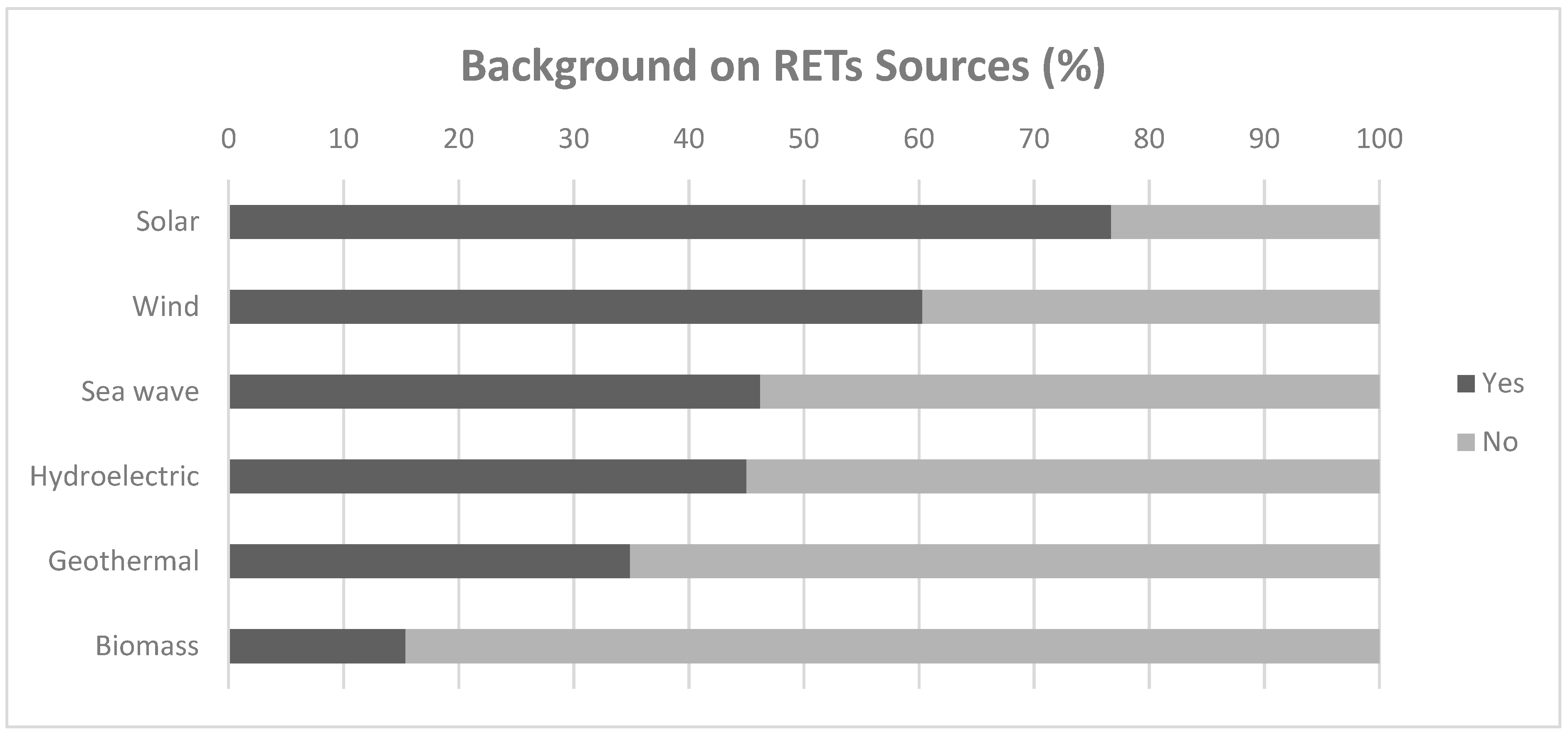
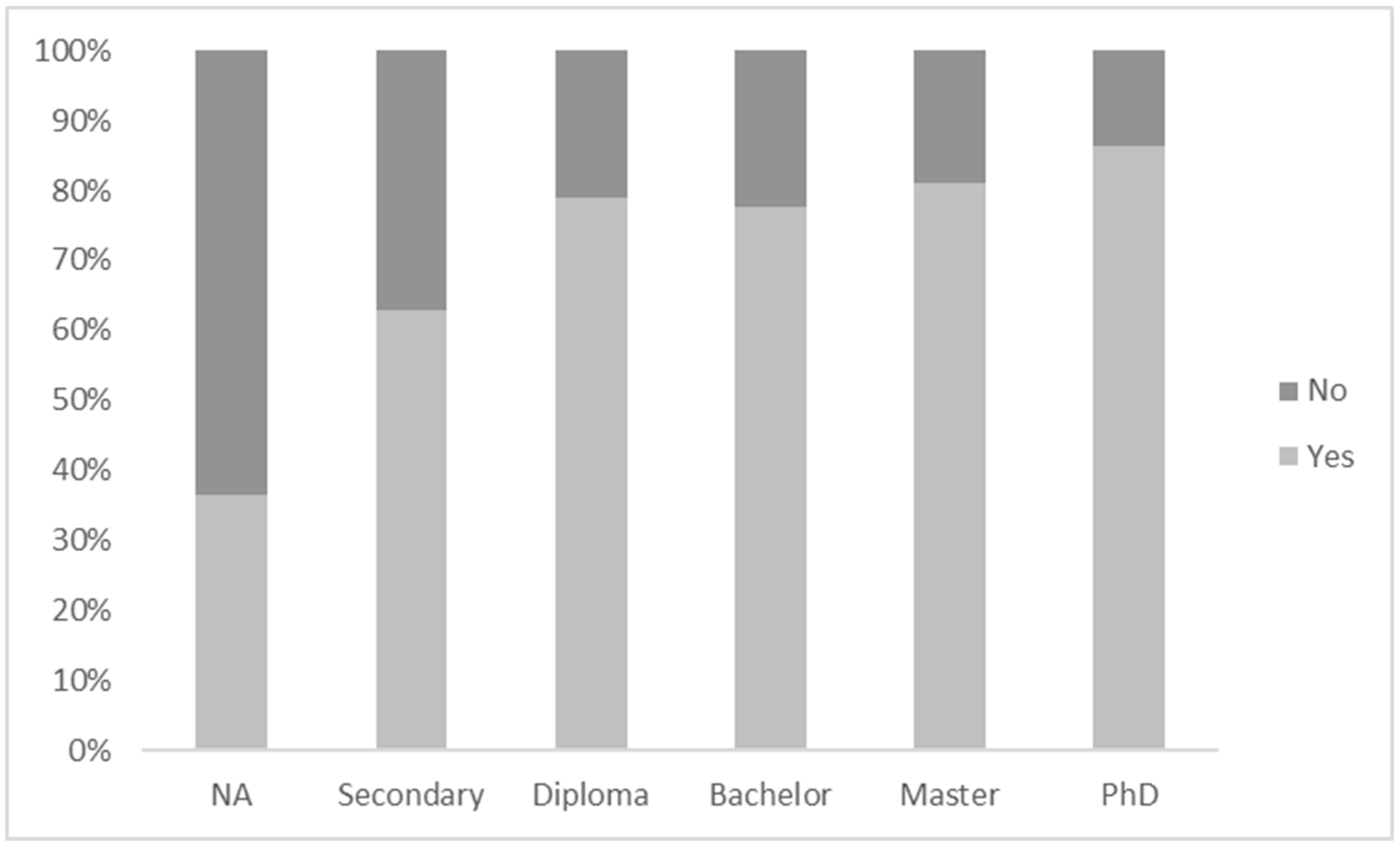
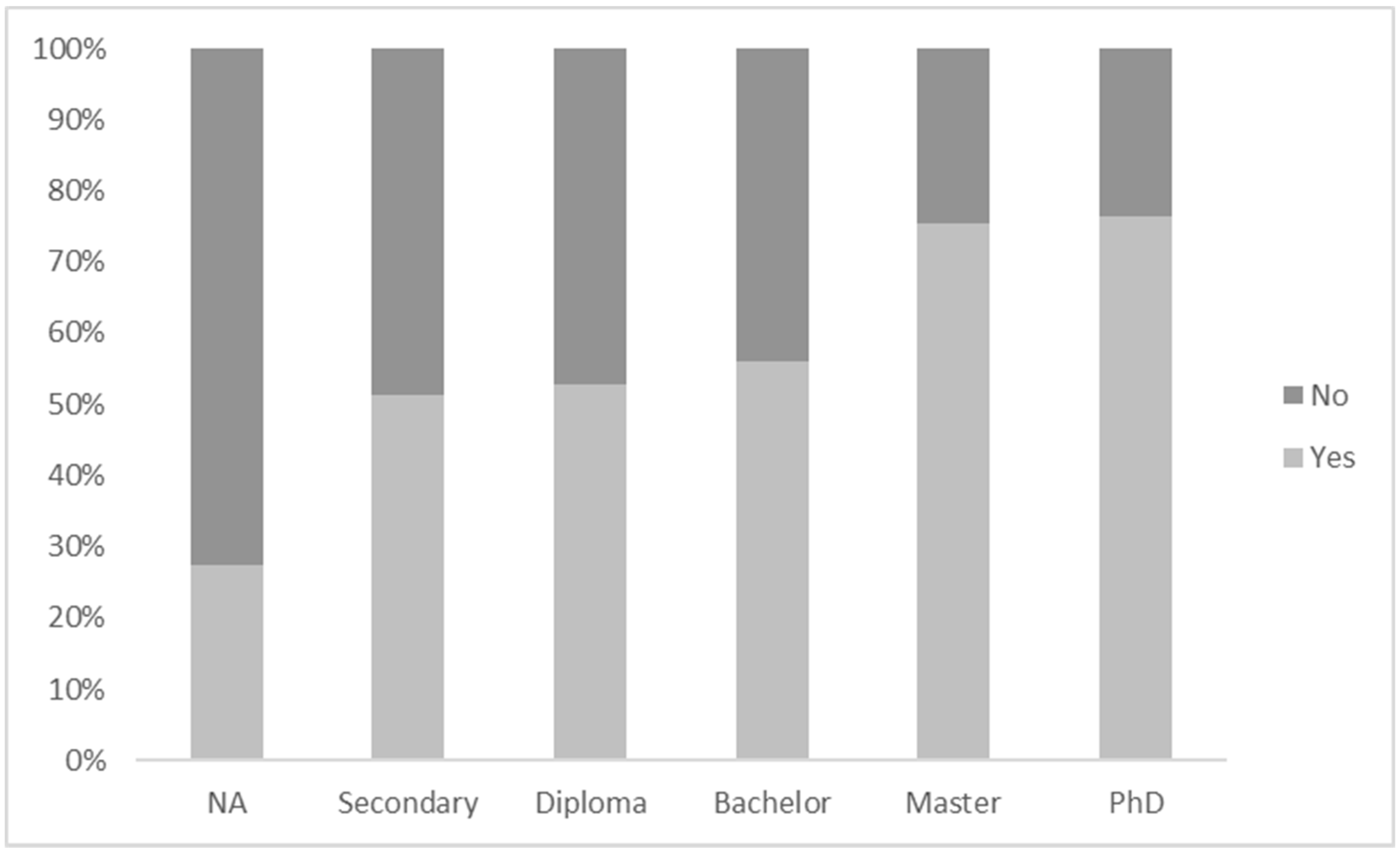
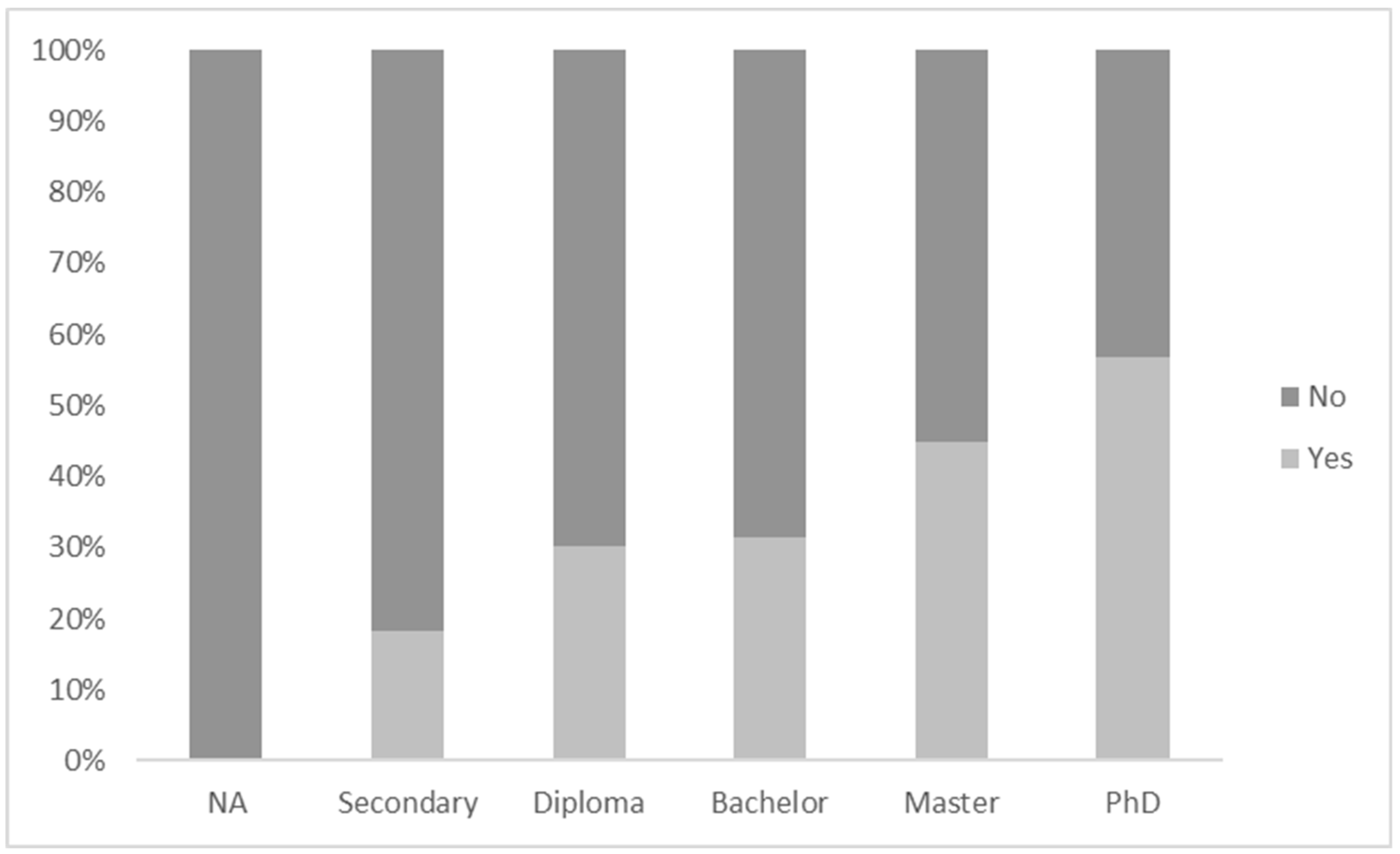
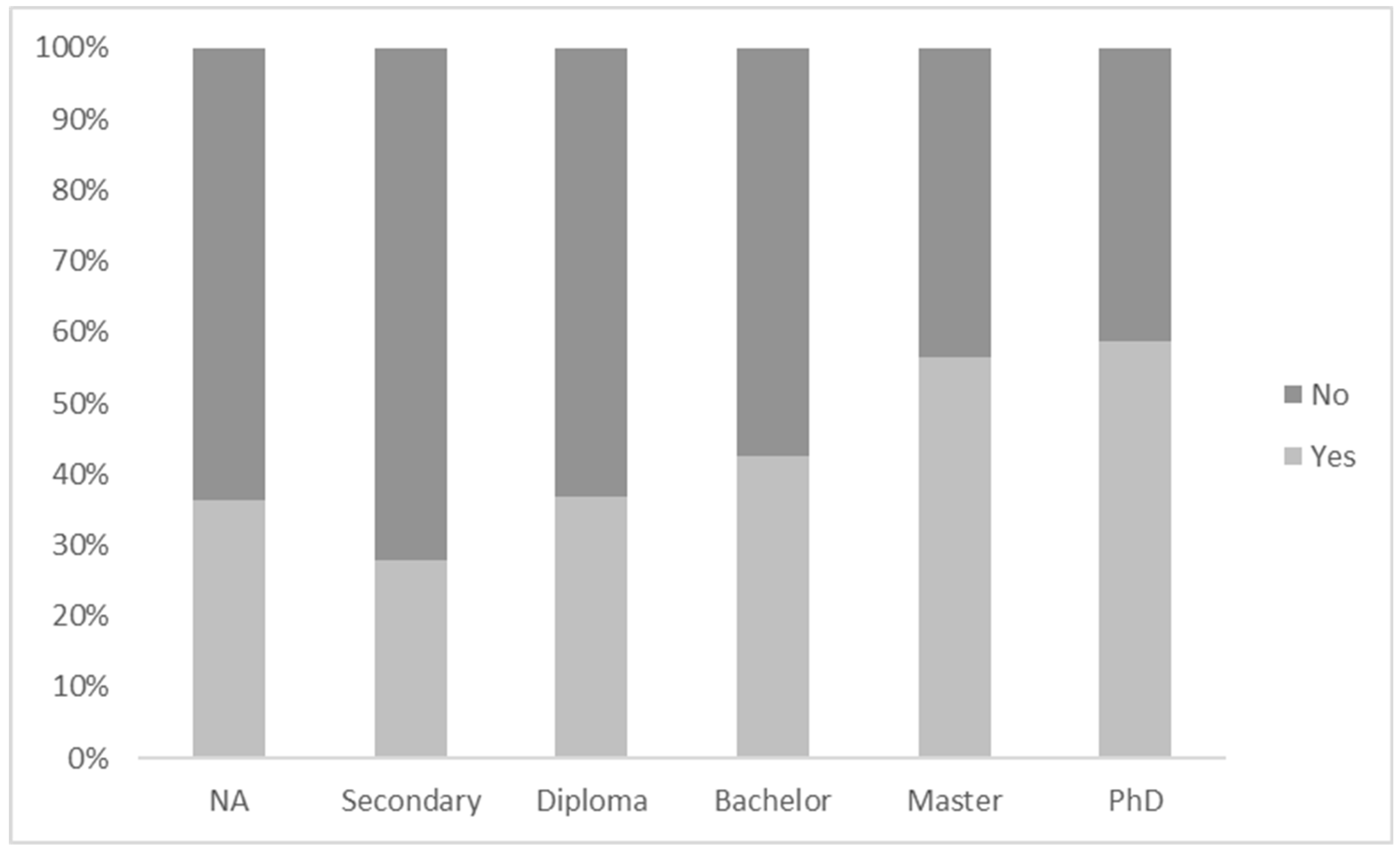
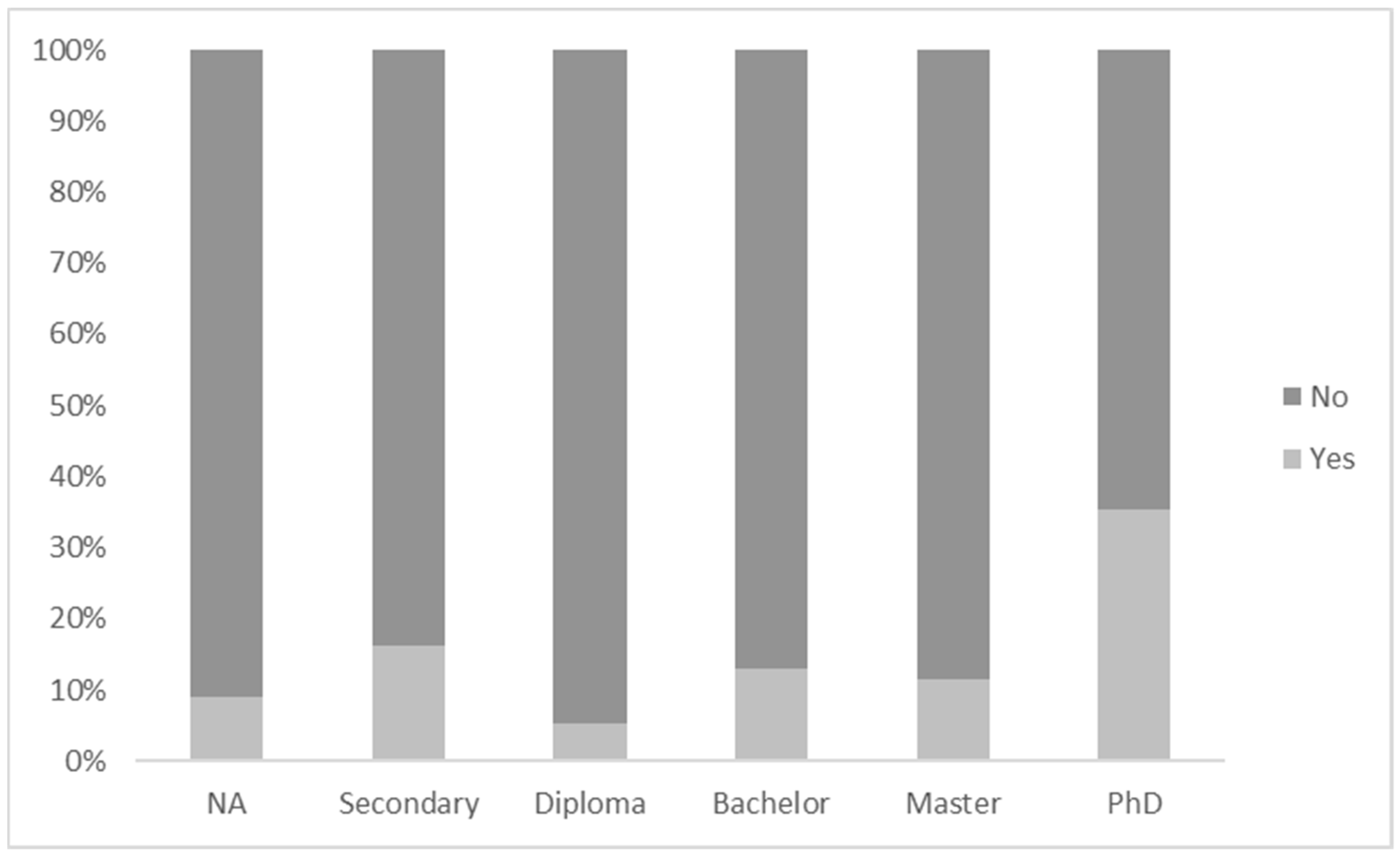
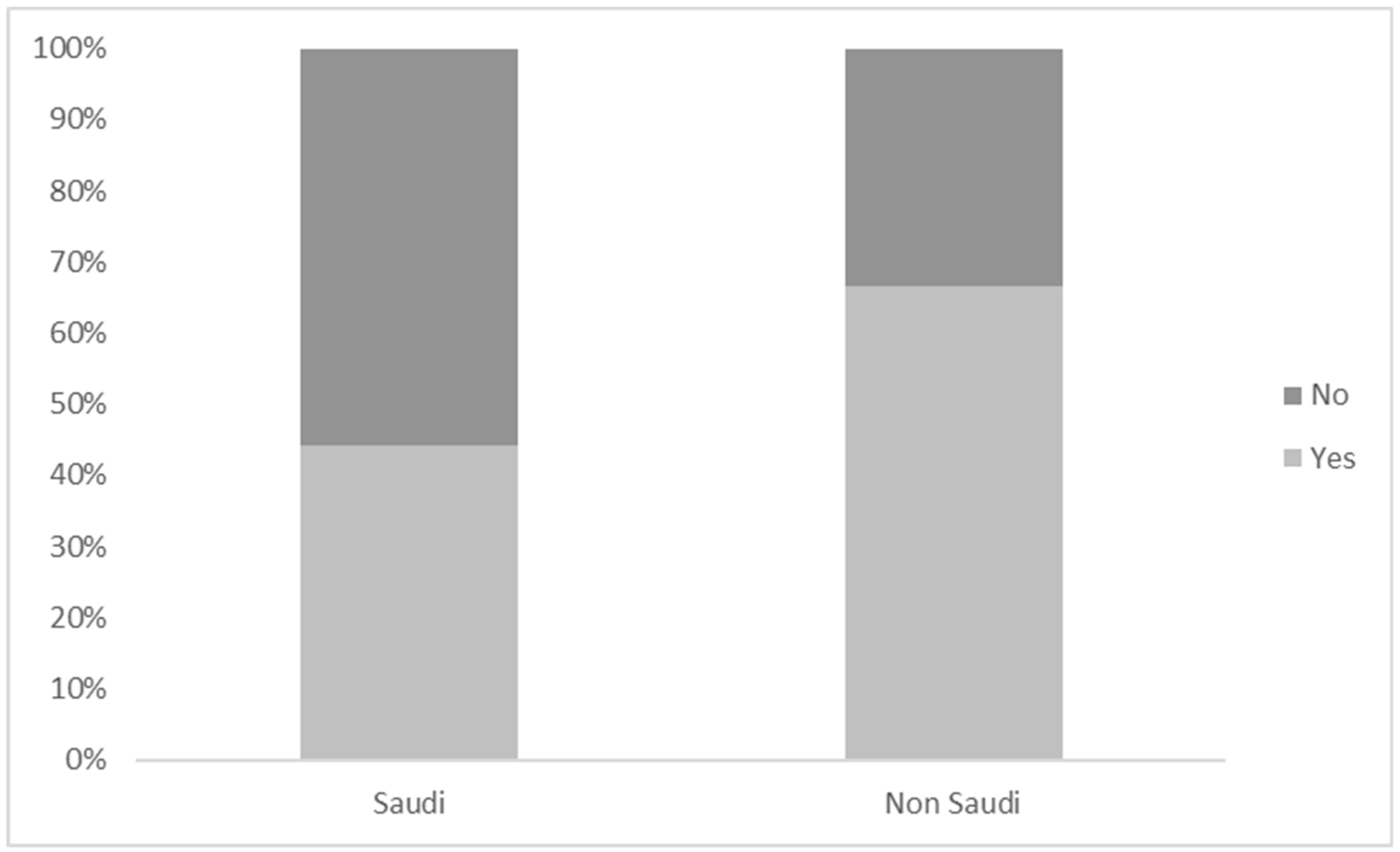


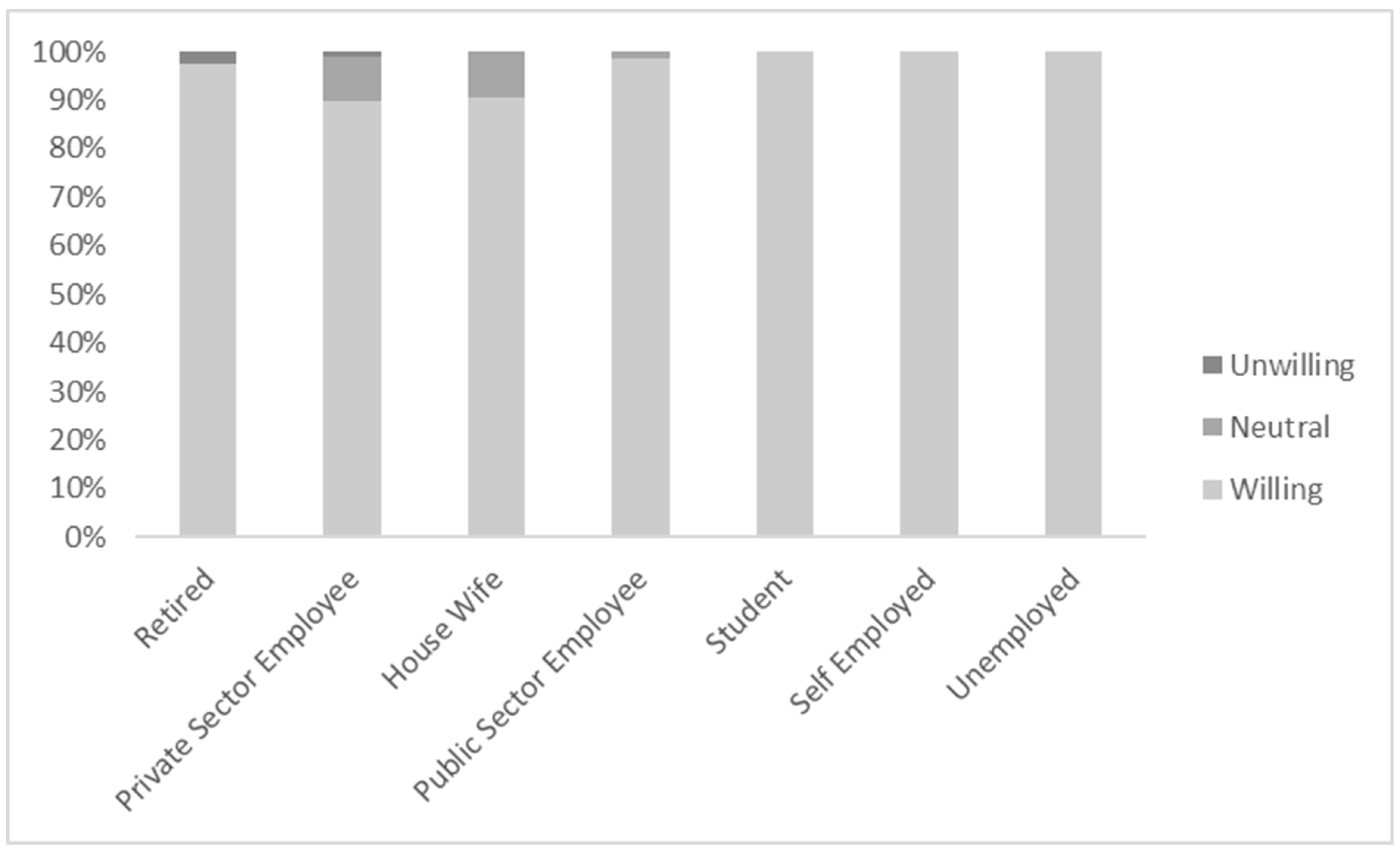

| Demographics | Groups | Frequency | Percentage (%) |
|---|---|---|---|
| Gender | Male | 231 | 55.5 |
| Female | 185 | 44.5 | |
| Nationality | Saudi | 380 | 91.3 |
| Non-Saudi | 36 | 8.7 | |
| Age (Years) | 18 to 29 | 123 | 29.6 |
| 30 to 39 | 132 | 31.7 | |
| 40 to 49 | 87 | 20.9 | |
| 50 or more | 74 | 17.8 | |
| Education level | NA | 11 | 2.6 |
| Secondary | 43 | 10.3 | |
| Diploma | 19 | 4.6 | |
| Bachelor’s | 223 | 53.6 | |
| Master’s | 69 | 16.6 | |
| PhD | 51 | 12.3 | |
| Monthly Income (Saudi Riyal) | Less than 5000 | 98 | 23.6 |
| 5001 to 10,000 | 86 | 20.7 | |
| 10,001 to 15,000 | 93 | 22.4 | |
| 15,001 to 20,000 | 82 | 19.7 | |
| 20,001 to 30,000 | 30 | 7.2 | |
| More than 30,000 | 27 | 6.5 | |
| Employment | Public sector employee | 143 | 34.4 |
| Private sector employee | 107 | 25.7 | |
| Student | 61 | 14.7 | |
| Retired | 40 | 9.6 | |
| Housewife | 32 | 7.7 | |
| Self-employed | 22 | 5.3 | |
| Unemployed | 11 | 2.6 | |
| Marital Status | Married | 290 | 69.7 |
| Single | 104 | 25 | |
| Other | 22 | 5.3 | |
| Accommodation Type | Apartment | 225 | 54.1 |
| Villa | 161 | 38.7 | |
| Other | 30 | 7.2 | |
| Accommodation Ownership | Owner | 222 | 53.4 |
| Rental | 158 | 38 | |
| Other | 36 | 8.7 |
| Sociodemographic Characteristic | Background Knowledge on RET Source | df a | χ2b |
|---|---|---|---|
| Education Level | Solar | 5 | 16.173 **,c |
| Education Level | Wind | 5 | 20.9712 **,c |
| Education Level | Geothermal | 5 | 29.053 ***,c |
| Education Level | Hydroelectric | 5 | 14.018 *,c |
| Education Level | Biomass | 5 | 15.554 **,c |
| Nationality | Sea Wave | 1 | 6.673 *,d |
| Sociodemographic Characteristic | Willingness Perspective | df | χ2a |
|---|---|---|---|
| Employment status | Save the environment | 12 | 22.257 ** |
| Age | Save the environment | 6 | 14.126 ** |
| Age | Pay more for using RETs | 6 | 18.852 ** |
© 2018 by the authors. Licensee MDPI, Basel, Switzerland. This article is an open access article distributed under the terms and conditions of the Creative Commons Attribution (CC BY) license (http://creativecommons.org/licenses/by/4.0/).
Share and Cite
Mosly, I.; Makki, A.A. Current Status and Willingness to Adopt Renewable Energy Technologies in Saudi Arabia. Sustainability 2018, 10, 4269. https://doi.org/10.3390/su10114269
Mosly I, Makki AA. Current Status and Willingness to Adopt Renewable Energy Technologies in Saudi Arabia. Sustainability. 2018; 10(11):4269. https://doi.org/10.3390/su10114269
Chicago/Turabian StyleMosly, Ibrahim, and Anas A. Makki. 2018. "Current Status and Willingness to Adopt Renewable Energy Technologies in Saudi Arabia" Sustainability 10, no. 11: 4269. https://doi.org/10.3390/su10114269
APA StyleMosly, I., & Makki, A. A. (2018). Current Status and Willingness to Adopt Renewable Energy Technologies in Saudi Arabia. Sustainability, 10(11), 4269. https://doi.org/10.3390/su10114269






